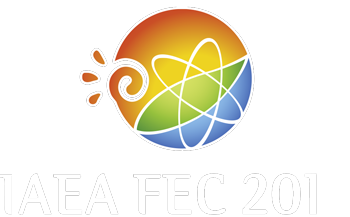Speaker
Dr
Rajaraman Ganesh
(Institute for Plasma Researh, Bhat Village, Gandhinagar 382428, Gujarat, INDIA)
Description
Turbulent transport of energy, particles and momentum is
one of the important limiting factors for long time
plasma confinement. Modern kinetic study using
gyrokinetic formalism and simulation has progressed
to identify several microinstabilities that cause ion
and electron thermal transport. Typically, these have
been ballooning parity modes such as the ITG, KBM and
ETG modes which cause transport through fluctuations or
tearing parity modes such as Microtearing modes (MTM)
which change the local magnetic topology and cause
transport through stochastization of the magnetic field.
Local gyrokinetic simulations have found collisional MTMs
unstable in several magnetic confinement configurations
such as Spherical Tokamaks, Reverse Field Pinch and
Standard Tokamaks. Aditya K Swamy et al. [Phys. Plasmas
21 (2014), 22 (2015)] have found global Collisionless
MTMs to be linearly unstable in regions high positive
magnetic shear. The collisionless MTM is found to be
driven unstable by the magnetic drift resonance of
passing electrons.
In this work, we address the complex multiscale problem
of MTM stability in advanced tokamak scenarios which
envisage reversed magnetic shear with observed strong
sheared poloidal and toroidal flows in the Internal
Transport Barrier. In the first part of this work, safety
factor profiles are continuously varied parametrically
from standard shear profiles to weak and reverse shear
profiles. Multiple MTM modes are found at finite
positive shear. As the global safety factor profile is
varied, novel mixed parity modes of MTMs are found to
become unstable with weak shear. In the second part, the
effect of equilibrium flows are studied for their effect
on MTM and mixed parity (MP) instabilities and their
global mode structures. These and several other
characteristics of MTMs and Mixed Parity modes will be
reported.
| Country or International Organization | India |
|---|---|
| Paper Number | TH/P3-7 |
Author
Mr
Deepak Verma
(Institute for Plasma Research, Bhat Gandhinagar 382428, India)
Co-authors
Dr
Aditya Krishna Swamy
(Institute for Plasma Research, Bhat Gandhinagar 382428 India)
Dr
Laurent Villard
(SPC, EPFL 1015 Lausanne, Switzerland)
Dr
Rajaraman Ganesh
(Institute for Plasma Researh, Bhat Village, Gandhinagar 382428, Gujarat, INDIA)
Dr
Stephan Brunner
(SPC, EPFL 1015 Lausanne, Swtizerland)

